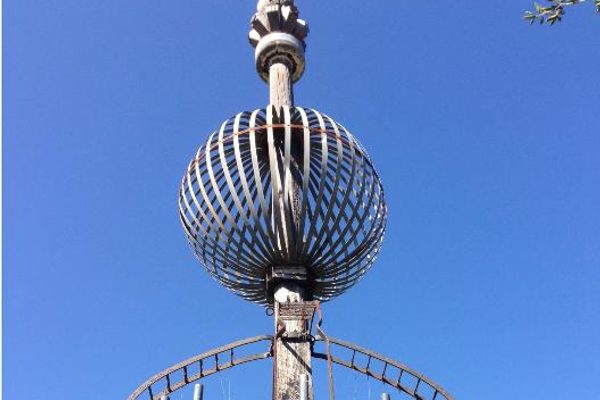Eerie Instruments Played by the Wind
“Singing, Ringing Tree,” played by the wind in Lancashire (photograph by Mark Tighe)
Other than the ubiquitous wind-chimes sounding on your balcony, there are a variety of instruments that are played only by the wind, ranging from those small enough to sit on your windowsill to massive pieces of modern art and poorly-designed skyscrapers.
While known in ancient Greece, India, and China, the Aeolian harp (“Aeolian” from the ancient Greek god and “keeper of the winds,” Aeolus) was “rediscovered” in Europe during the 1650s, by Athanasius Kircher, a German Jesuit priest, and went on to become a popular feature in Romantic-era households. The idea is simple: a number of strings (usually an even number) are strung over a sound chamber, and the instrument is then left somewhere with a strong breeze. The wind does the rest.
Aeolian harp revived by Athanasius Kircher, illustrated by Friedrich Schultes, woodcut on paper (1684) (via Deutsche Fotothek)
The modern world has never gotten over this obsession with wind-played instruments, and Aeolian harps can be found all across the planet. And there are other instruments played by or involving nature, such as the Wave Organ in San Francisco, the Singing Drain Pipes in Kunsthofpassage, Germany, and the Great Stalactite Organ in Luray, Virginia. Yet from the coast of California to the Eden Project, the humming of Aeolian harps can be heard. The instruments themselves are interesting, not only because they are played by the wind, but also because they are the only instruments that can play only chords.
At the Exploratorium in San Francisco, quite near the Wave Organ, sits a 27-foot-tall Aeolian harp, designed by local artist Doug Hollis. The harp is situated to be strummed by the fingers of the wind that pass through a wind tunnel, creating an eerie humming sound.
Other Californian Aeolian Harps include the Lucia and Aristides Demetrios Wind Harp, also in San Francisco, which, at 92 feet, is the largest wind harp in the world, and the Solvang Wind Harp, which appears to have fallen into a terrible state of disrepair.
Oodena Celebration Circle (photograph by AJ Batac)
Winnipeg, Canada, has an extraordinary wind harp, at the Forks, as part of the Oodena Celebration Circle. The Forks is a community meeting place in Winnipeg, and the impressive-looking Forks mark the autumnal equinox and the summer and winter solstices. The location is believed to date back 6,000 years as a place of gathering.
World’s Largest Fiddle (photograph by Mark Seymour)
Another Canadian wind harp is on the shores of Cape Breton, in Nova Scotia. This wind harp also doubles as the world’s largest fiddle, built to celebrate the city’s Celtic past.
In both the United Kingdom and Ireland, as well as in Continental Europe, Aeolian harps can be found along isolated stretches of coast, being played by strong sea winds. Examples can also be discovered in Germany, Denmark, and Sweden. Two particular sculptures in the United Kingdom are resoundingly modern takes on the concept of the Aeolian harp — the Singing, Ringing Tree in Burnley, and the Aeolus mounted on the grounds of the Eden Project, in their “Wild Chile” zone, designed by British artist Luke Jerram.
Certain skyscrapers are known to sing (or hum) in heavy winds, such as Beetham Tower in Manchester, and (reportedly) the new One World Trade Center tower. The most likely cause of buildings acting as Aeolian harps is usually due to the placement of louvers or antennae, and a failure to take the wind into account during the design and construction phases.
While these are all incredible engineering marvels, you can make your own Aeolian harp pretty easily — just head here at Instructables and you’ll soon see how. And keep in mind these words from Ralph Waldo Emerson’s “Maiden Song of the Aeolian Harp”:
Keep your lips or finger-tips
For flute or spinet’s dancing chips;
I await a tenderer touch
I ask more or not so much:
Give me to the atmosphere.





























Follow us on Twitter to get the latest on the world's hidden wonders.
Like us on Facebook to get the latest on the world's hidden wonders.
Follow us on Twitter Like us on Facebook